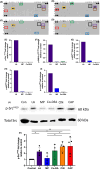c-Src activation as a potential marker of chemical-induced skin irritation using tissue-engineered skin equivalents
- PMID: 36457227
- PMCID: PMC10946902
- DOI: 10.1111/exd.14719
c-Src activation as a potential marker of chemical-induced skin irritation using tissue-engineered skin equivalents
Abstract
Skin irritancy to topically applied chemicals is a significant problem that affects millions of people worldwide. New or modified chemical entities must be tested for potential skin irritancy by industry as part of the safety and toxicity profiling process. Many of these tests have now moved to a non-animal-based format to reduce experiments on animals. However, these tests for irritancy potential often rely on monolayer cultures of keratinocytes that are not representative of the skin architecture or tissue-engineered human skin equivalents (HSE) using complex multi-gene expression panels that are often cumbersome and not amenable for high throughput. Here, we show that human skin equivalents increase abundance of several phosphorylated kinases (c-Src, c-Jun, p53, GSK3α/β) in response to irritant chemical stimulation by phosphokinase array analysis. Specific phosphorylation of c-SrcY419 was confirmed by immunoblotting and was plasma membrane-associated in basal/spinous cells by phospho-specific immunohistochemistry. Moreover, c-SrcY419 phosphorylation in response to the irritants lactic acid and capsaicin was inhibited by the c-Src inhibitors KB-SRC and betaine trimethylglycine. These data provide the first evidence for c-Src specific activation in response to chemical irritants and point to the development of new modes of rapid testing by immunodetection for first-pass screening of potential irritants.
Keywords: c-Src; irritation; signal transduction; skin; toxicity.
© 2022 The Authors. Experimental Dermatology published by John Wiley & Sons Ltd.
Conflict of interest statement
MZH, HN, and TF are employees of Rohto Pharmaceutical Company Limited, the industrial partner for the project. The remaining authors state no conflict of interest.
Figures

 ,
,  ,
,  ,
,  ,
,  ,
,  . Densitometry analysis of array immunoblots showing fold‐change abundance of phosphokinases in LA, MP or CO‐DEA treated HSE relative to water controls for SrcY419 (E), GSK3α/βS21/S9 (F), p53S15 (G), p53S46 (H) and c‐JunS63 (I) (n = 2 independent experiments). Immuno‐blot analysis of HSE for phospho‐c‐SrcY419 abundance compared with total c‐Src upon stimulation with water control (con), LA, MP, Co‐DEA, CIN or CAP for 15 min (J). Densitometric analysis showing fold change in phospho‐c‐SrcY
419 relative to total c‐Src (K). Data are mean ± SD for n = 3 independent experiments *p < 0.05, **p < 0.01 by one‐way ANOVA with Tukey's multiple comparison post hoc test. The map accompanying the phosphokinase array is shown in Figure S2.
. Densitometry analysis of array immunoblots showing fold‐change abundance of phosphokinases in LA, MP or CO‐DEA treated HSE relative to water controls for SrcY419 (E), GSK3α/βS21/S9 (F), p53S15 (G), p53S46 (H) and c‐JunS63 (I) (n = 2 independent experiments). Immuno‐blot analysis of HSE for phospho‐c‐SrcY419 abundance compared with total c‐Src upon stimulation with water control (con), LA, MP, Co‐DEA, CIN or CAP for 15 min (J). Densitometric analysis showing fold change in phospho‐c‐SrcY
419 relative to total c‐Src (K). Data are mean ± SD for n = 3 independent experiments *p < 0.05, **p < 0.01 by one‐way ANOVA with Tukey's multiple comparison post hoc test. The map accompanying the phosphokinase array is shown in Figure S2.

References
-
- Misery L, Stander S, Szepietowski JC, et al. Definition of sensitive skin: an expert position paper from the special interest group on sensitive skin of the international forum for the study of itch. Acta Derm Venereol. 2017;97(1):4‐6. - PubMed
-
- Natsch A, Bauch C, Foertsch L, et al. The intra‐ and inter‐laboratory reproducibility and predictivity of the KeratinoSens assay to predict skin sensitizers in vitro: results of a ring‐study in five laboratories. Toxicol In Vitro. 2011;25(3):733‐744. - PubMed
-
- Emter R, Ellis G, Natsch A. Performance of a novel keratinocyte‐based reporter cell line to screen skin sensitizers in vitro . Toxicol Appl Pharmacol. 2010;245(3):281‐290. - PubMed
-
- Ramirez T, Mehling A, Kolle SN, et al. LuSens: a keratinocyte based ARE reporter gene assay for use in integrated testing strategies for skin sensitization hazard identification. Toxicol In Vitro. 2014;28(8):1482‐1497. - PubMed
-
- Cottrez F, Boitel E, Auriault C, Aeby P, Groux H. Genes specifically modulated in sensitized skins allow the detection of sensitizers in a reconstructed human skin model. Development of the SENS‐IS assay. Toxicol In Vitro. 2015;29(4):787‐802. - PubMed
Publication types
MeSH terms
Substances
LinkOut - more resources
Full Text Sources
Medical
Research Materials
Miscellaneous

